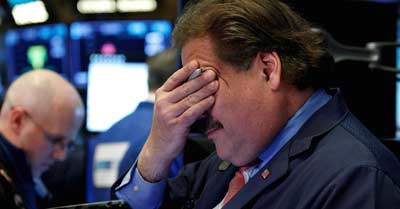Trader: Four Reasons Why "The Worst For Markets Is Yet To Come"
Tyler Durden
 Following a recent barrage of negativity from former Lehman trader and current Bloomberg macro commentator, Mark Cudmore, who warned that stocks are likely to continue sliding as a short squeeze in bonds sends yields lower, overnight his Bloomberg Markets Live colleague and macro commentator, Garfield Reynolds, echoed Cudmore's growing pessimism, urging readers to "Rest Up This Easter Because Markets Face an Ugly Q2" and that "the worst for markets is yet to come" for four reasons he lists below. Following a recent barrage of negativity from former Lehman trader and current Bloomberg macro commentator, Mark Cudmore, who warned that stocks are likely to continue sliding as a short squeeze in bonds sends yields lower, overnight his Bloomberg Markets Live colleague and macro commentator, Garfield Reynolds, echoed Cudmore's growing pessimism, urging readers to "Rest Up This Easter Because Markets Face an Ugly Q2" and that "the worst for markets is yet to come" for four reasons he lists below.
His full Macro View is below:
Rest Up This Easter Because Markets Face an Ugly Q2: Macro View
Risk assets look to be in dire need of the Easter break because the second quarter has every chance of being more stressful than the first.
Volatility across bonds, FX and stocks is soaring. This quarter’s jump in implied vol is the most since the European debt crisis escalated in 2011 and it’s the sort of steep shift only seen on two prior occasions: the LTCM meltdown of 1998 and the Lehman-led crash of 2008.
Actual volatility is also exploding, with the U.S. benchmark leading the way for the first time since 2008 too. Oh, and the 206% surge in 90-day realized volatility for the S&P 500 has only been topped twice, in 1987 and 1930.
The market turmoil has been greeted with some bemusement due to the lack of an obvious real-world reason. "The fundamentals are still strong" is the catchcry. But the jump in volatility is in itself the key fundamental change.
It has fueled broader risk aversion, helping to explain why the MSCI All-World Index of global stocks is poised to snap a seven-quarter winning streak - - its longest stretch of gains since 1997 -- and global bonds are set for their first decline in currency-neutral terms since 2016.
There are signs that it’s correct to be pricing in a marked deterioration from 2017’s perfect low-volatility rally. Global data is breaking down too fast for economists to keep up. Both Westpac’s data pulse index, which tracks outcomes relative to prior reports, and Citigroup’s surprise gauge are rapidly heading south.
The outperformance of Australia’s bond market, from the stunning inversion of the yield premium it has usually enjoyed over the U.S., to the drop in its yield curve under 50 bps and the evaporation of bets on RBA hikes, is another warning sign.
Australia is the large developed economy most tightly bound to the global-growth engine that is China, so it’s hard to see how the global uptick story makes sense when the land Down Under is being left behind.
Credit spreads are widening the most since 2016. This has been one of the few constants this quarter and will keep risk assets under pressure.
The worst for markets is yet to come:
- The S&P 500 has yet to really break down -- the longer it holds above the 200-day moving average, the bigger the crash will likely be when it happens
- WTI has again failed to hold above $65, forming a very ominous double top that must make the near- record net longs for WTI nervous. With U.S. output surging, and sliding commodities signaling a slowdown in demand for raw materials, the stars are aligning for a big, disinflationary step down by crude
- Treasury 10-year yields have had to be dragged down kicking-and-screaming because the Fed is sticking to its dots, but the latest capitulation of the term premium forewarns of a larger collapse in rates
- When they do, that will cast doubt on the Fed’s guidance and spread a fresh wave of disruption across assets that will start out in bonds, currently less volatile than FX and stocks relative to historical norms
So, rest up and enjoy those chocolates.
 our mission: our mission:
to widen the scope of financial, economic and political information available to the professional investing public.
to skeptically examine and, where necessary, attack the flaccid institution that financial journalism has become.
to liberate oppressed knowledge.
to provide analysis uninhibited by political constraint.
to facilitate information's unending quest for freedom.
our method: pseudonymous speech...
Anonymity is a shield from the tyranny of the majority. it thus exemplifies the purpose behind the bill of rights, and of the first amendment in particular: to protect unpopular individuals from retaliation-- and their ideas from suppression-- at the hand of an intolerant society.
...responsibly used.
The right to remain anonymous may be abused when it shields fraudulent conduct. but political speech by its nature will sometimes have unpalatable consequences, and, in general, our society accords greater weight to the value of free speech than to the dangers of its misuse.
Though often maligned (typically by those frustrated by an inability to engage in ad hominem attacks) anonymous speech has a long and storied history in the united states. used by the likes of mark twain (aka samuel langhorne clemens) to criticize common ignorance, and perhaps most famously by alexander hamilton, james madison and john jay (aka publius) to write the federalist papers, we think ourselves in good company in using one or another nom de plume. particularly in light of an emerging trend against vocalizing public dissent in the united states, we believe in the critical importance of anonymity and its role in dissident speech. like the economist magazine, we also believe that keeping authorship anonymous moves the focus of discussion to the content of speech and away from the speaker- as it should be. we believe not only that you should be comfortable with anonymous speech in such an environment, but that you should be suspicious of any speech that isn't.
www.zerohedge.com
| 



